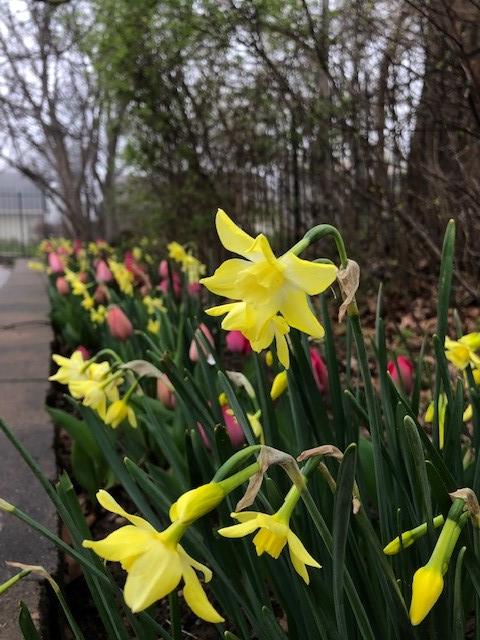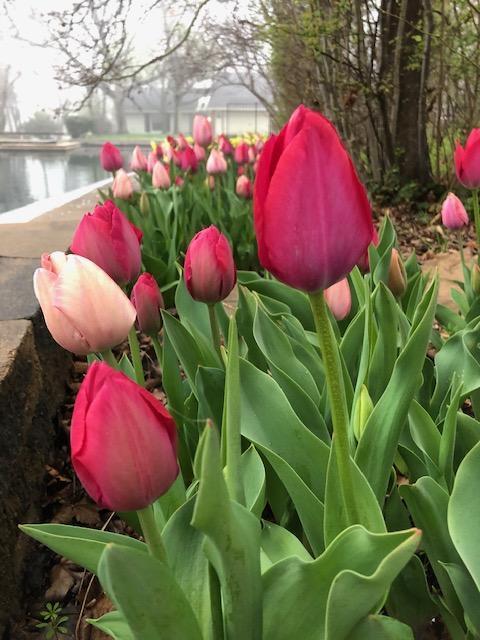Column and Story by Diane Ford, Garfield County Master Gardener
If you are old enough to remember a song by Carly Simon entitled “Anticipation,” you will start to understand a gardener’s feelings in spring, months after planting tulip bulbs. You wait and wait until the magic moment arrives when waking one morning you look out the window to see glorious shouts of color swaying on graceful stems. If you are fortunate, the tulips arrive for a short period of time to indicate the end of winter and a renewal of life. If you are not fortunate, you may get just a few spindly pops of color that leave your garden with hardly any notice. I have experienced both over the past few years and have learned a few lessons for success to share with you.
But first a little history about the tulip that may help explain its growing success and popularity which started not in Holland, as I had believed, but in Turkey. While families in most of Western Europe in the early 1600s planted gardens for food, the Turks were planting gardens for beauty as well. Among the flowers they enjoyed, was the tulip, which grew naturally in their mountainous gardens. A Dutch trader, named Carolus Clusius, was fascinated by the simple shape yet bold colors of the tulips. He returned to the Netherlands with bulbs that he planted in the gardens of the wealthy. When friends left his home, they left with 200-300 tulip bulbs as a gift, thus spreading the idea of flower gardens. The cool winter climate and the sandy soil of Holland created an ideal location to cultivate these bright bits of color after a dark winter season. At the same time, the Dutch were experiencing their Golden Age of trade and wealth. They had a particular genius for creating desire and need for their products, including tulips.

Fast forward to the United States in 2020. Most of our yards now are devoted to flower gardens. We can purchase what seems like an unlimited variety of plants to match our growing conditions. We can buy bulbs locally or purchase at wholesale prices if we choose to plant in quantity. I dove into tulips a few years ago after hearing about a wholesaler, Colorblends. The blooms were astounding the first year after I planted. But the following year very few came up, which was quite a disappointment. Since then, I have researched and use the following tips in my garden:
- Plant bulbs in late October or November. Tulip bulbs require consistent cool weather to put down their roots. As they grow, they will need 6 hours of sun each day.
- Bulbs do best in well-drained soil with sand and compost to allow that drainage. Check to ensure your soil is Ph neutral. If the soil is dry when you plant, water moderately. Bulbs will rot if they get too much water. Irrigation systems that water regularly for other plants and grass may have a detrimental effect on tulip bulbs.
- Plant your bulbs at a depth of 4X the height of the bulb.
- Tulips can be classified as early, medium, or late bloomers. (Colorblends makes this classification.) To extend the blooming season, I plant early and late bloomers mixed in with each other. As the early flowers are wilting the late bloomers pop up, extending their color for up to a month. Sometimes I have a totally different color of tulip popping up with the second round.
- My observation is that squirrels and other rodents may dig up the bulbs for a mid-winter snack. I now plant daffodils with the tulips. It adds to the beauty and rodents and deer stay away because of the daffodils.
- This last tip may be hard to digest. To get truly large and brilliant colored blooms each year you may need to plant new bulbs each year. The new hybrids give all their glory the first year after planting instead of reproducing themselves into new, hardy offspring. You can try perennial tulips or Giant Darwinian varieties.
Whether you plant a small cluster of tulips, or a large array, the best feeling during the grey days of winter is the anticipation for all the gloriously colored blooms come spring.






